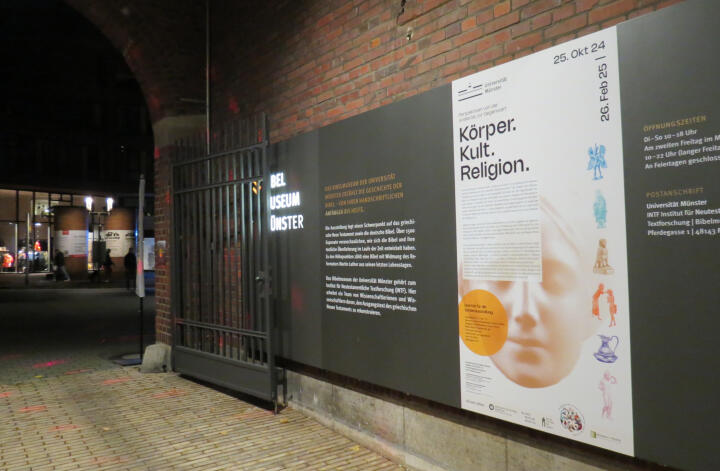Essential for the Transfer to Society
Image Gallery

‘Our museums are not just a small hobby for the university, but essential for social transfer’. At the exhibition opening on Friday, 25 October, Vice-Rector Prof. Michael Quante expressed his enthusiasm for the ‘Körper.Kult.Religion’ show. It is ‘exemplary for the provision of socio-cultural knowledge, without which we will not be able to cope in our society in the long term’. In particular, he emphasised the intercultural multi-perspectivity of the project, which was realised by the Cluster of Excellence ‘Religion and Politics’ . Representatives from around 15 disciplines at the university, such as Classical Studies, Theology, Sociology and Cultural Studies, took part.
Consequently, the exhibition, which can be seen in the Archaeological Museum and the Bible Museum until 26 February 2025, is not just ‘an illustration of the research, but part of the research’, emphasised Prof. Michael Seewald, the spokesperson for the cluster. This becomes clear, for example, in the seven hands-on stations where visitors can vote on whether they keep fasting commandments or whether there is an immortal soul. The question of whether the exhibition has changed people's view of their own bodies and their relationship to religious beliefs will also be analysed.
For although the body in its manifestations is a deeply individual phenomenon, the way it is treated characterises social debates. The discussion about headscarves or the ban on abortion moves people; the latter, for example, is one of the most important issues in the current US presidential election campaign. ‘Supposedly secular discourses are deeply rooted in religious ideas,’ explained Prof Achim Lichtenberger, Director of the Archaeological Museum.
The complexity and depth of the relationship between the body and religions that are often misunderstood as hostile to the body is demonstrated by almost 200 exhibits that have been loaned from internationally renowned museums such as the Louvre in Paris and the Kunsthistorisches Museum in Vienna. The statuette of the Greek god Hermaphroditos from Liverpool, for example, makes it clear that even 2,000 years ago there was a greater openness towards fluid understandings of gender than is often the subject of fierce debate today. The death mask of an unknown beauty from the Seine is exemplary of the attempts to preserve the transient body for all eternity.
For Prof Holger Strutwolf, Director of the Bible Museum, it is clear that the physical cannot be conceived without the religious. ‘Religion knows of no spiritualisation of the body that is not at the same time a corporealisation of the spirit,’ he concluded, quoting the physician, social reformer and philosopher Franz von Baader.
‘Body.Cult.Religion’ can be seen at the Archaeological and Bible Museum until 26 February 2025. Admission is six/three euros, free for students of the University of Münster. A catalogue has been published to accompany the exhibition, which can be purchased on site at a price of 29 euros.






